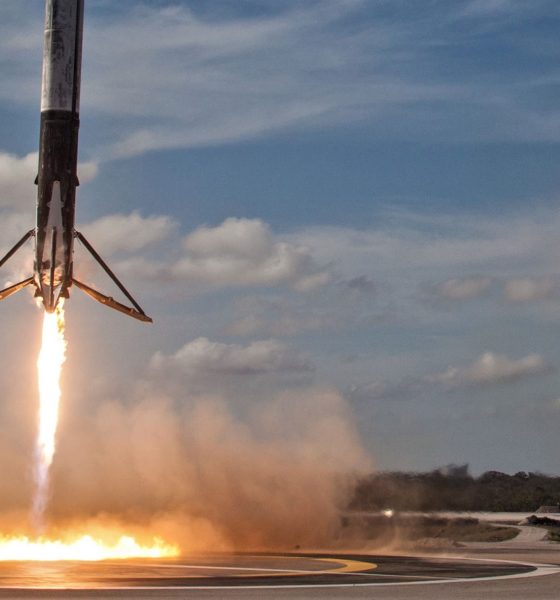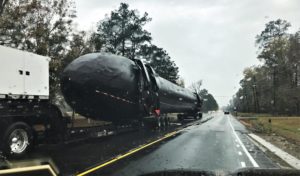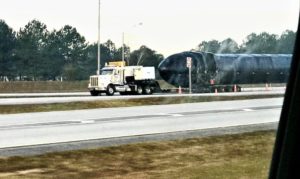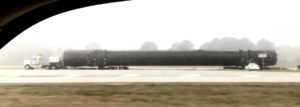

News
SpaceX’s next Falcon Heavy reaches milestone as third booster arrives in FL
A new SpaceX rocket was spotted traveling into Florida yesterday on its way to one of the company’s several Cape Canaveral booster storage and processing hangars. More likely than not, this particular booster is the second Falcon Heavy center core ever built, a heavily modified variant of Falcon 9’s first stage.
With the presumed center core’s arrival, all three Falcon Heavy boosters are now at or near SpaceX Launch Complex 39A, a major step forward for the second flight of the super heavy-lift launch vehicle, currently NET March 2019. Aside from the first stage, it appears that Falcon Heavy Flight 2’s payload fairing may have also arrived at Cape Canaveral around the end of January.

Captured by SpaceX Facebook group member Joshua Murrah on the morning of February 11th, the shrinkwrapped Falcon booster and truck were stopped at a weigh station on the border of Alabama and Florida, a now-common location for core spottings thanks to its adjacency to Mr. Murrah’s daily commute. No more than an 8-10 hour drive from Florida’s East Coast and Kennedy Space Center, the rocket likely arrived at its destination sometime within the last 12 or so hours.
While Falcon Heavy hardware would normally be expected to head straight for SpaceX’s hangar at Pad 39A, the only facility currently capable of launching the triple-booster rocket, the company faces a mild logistical challenge thanks to the terminally delayed launch debut of Crew Dragon. As of now, Crew Dragon, Falcon 9, and 39A’s transporter/erector (T/E) are integrated inside the pad’s hangar, leaving very little space for additional rocket processing as a result of the sheer scale of the T/E. Past photos of SpaceX’s 39A hangar illustrate that it can nominally house 4 or 5 Falcon boosters with ease, but space becomes far more limited once the T/E is rolled inside.
there might actually be juuuust enough room to literally fit them per FH Flight 1 processing pics, but only enough for Falcon Heavy integration if the TE remains outside. Will be very curious to see how SpaceX handles this, it's one hell of a logistical puzzle 😅 pic.twitter.com/D5BFXQnQ3V
— Eric Ralph (@13ericralph31) January 30, 2019
In essence, Falcon Heavy Flight 2 will likely have to wait until Crew Dragon has completed its launch debut before SpaceX technicians and engineers can begin integrating its three boosters and verifying that all is healthy, only the second time SpaceX will have performed those procedures. Crew Dragon’s uncrewed demonstration mission (DM-1) is currently scheduled for NET March 2nd, although there is a high probability that it will slip at least a few more days into March, if not further. Prior to its latest March 2nd launch target, Crew Dragon was expected to launch sometime in mid-to-late January as of December 2018, a date that has effectively remained 30+ days away ever since.
It’s ambiguous what the causes of those delays are and SpaceX and NASA clearly have no interest in directly tackling an explanation, but the most likely reason can be found in a painfully mundane reality: paperwork, worsened by a record-length US goverment shutdown. While both partners are likely culpable in some way, the fact remains that SpaceX has a long history of doing difficult things faster and cheaper than the old guard perceives as possible, while NASA has its own decades-long history of doing difficult things with extreme caution (for better or for worse).
- The second (and third) flight of Falcon Heavy is even closer to reality as the first new side booster heads to Florida after finishing static fire tests in Texas. (Reddit /u/e32revelry)
- SpaceX Facebook group member Joshua Murrah captured two great photos of the second Falcon Heavy side booster to arrive in Florida in the last month. (Joshua Murrah, 01/17/19)
- SpaceX Facebook group member Joshua Murrah also captured what is likely the third Falcon Heavy booster’s Florida arrival. (Joshua Murrah, 02/11/19)
- Falcon Heavy ahead of its inaugural launch. (SpaceX)
With any luck, Crew Dragon will successfully launch into orbit for the first time in the first several days of March, leaving enough buffer for SpaceX to rapidly integrate, checkout, and static-fire Falcon Heavy for an operational launch debut – carrying communications satellite Arabsat 6A – near the end of March. If all goes well, Falcon Heavy’s third launch – the USAF’s second Space Test Program mission (STP-2) – could occur as early as April 2019, potentially just a month after Flight 2.

Elon Musk
Elon Musk’s X will start using a Tesla-like software update strategy
The initiative seems designed to accelerate updates to the social media platform, while maintaining maximum transparency.

Elon Musk’s social media platform X will adopt a Tesla-esque approach to software updates for its algorithm.
The initiative seems designed to accelerate updates to the social media platform, while maintaining maximum transparency.
X’s updates to its updates
As per Musk in a post on X, the social media company will be making a new algorithm to determine what organic and advertising posts are recommended to users. These updates would then be repeated every four weeks.
“We will make the new 𝕏 algorithm, including all code used to determine what organic and advertising posts are recommended to users, open source in 7 days. This will be repeated every 4 weeks, with comprehensive developer notes, to help you understand what changed,” Musk wrote in his post.
The initiative somewhat mirrors Tesla’s over-the-air update model, where vehicle software is regularly refined and pushed to users with detailed release notes. This should allow users to better understand the details of X’s every update and foster a healthy feedback loop for the social media platform.
xAI and X
X, formerly Twitter, has been acquired by Elon Musk’s artificial intelligence startup, xAI last year. Since then, xAI has seen a rapid rise in valuation. Following the company’s the company’s upsized $20 billion Series E funding round, estimates now suggest that xAI is worth tens about $230 to $235 billion. That’s several times larger than Tesla when Elon Musk received his controversial 2018 CEO Performance Award.
As per xAI, the Series E funding round attracted a diverse group of investors, including Valor Equity Partners, Stepstone Group, Fidelity Management & Research Company, Qatar Investment Authority, MGX, and Baron Capital Group, among others. Strategic partners NVIDIA and Cisco Investments also continued support for building the world’s largest GPU clusters.
News
Tesla FSD Supervised wins MotorTrend’s Best Driver Assistance Award
The decision marks a notable reversal for the publication from prior years, with judges citing major real-world improvements that pushed Tesla’s latest FSD software ahead of every competing ADAS system.

Tesla’s Full Self-Driving (Supervised) system has been named the best driver-assistance technology on the market, earning top honors at the 2026 MotorTrend Best Tech Awards.
The decision marks a notable reversal for the publication from prior years, with judges citing major real-world improvements that pushed Tesla’s latest FSD software ahead of every competing ADAS system. And it wasn’t even close.
MotorTrend reverses course
MotorTrend awarded Tesla FSD (Supervised) its 2026 Best Tech Driver Assistance title after extensive testing of the latest v14 software. The publication acknowledged that it had previously criticized earlier versions of FSD for erratic behavior and near-miss incidents, ultimately favoring rivals such as GM’s Super Cruise in earlier evaluations.
According to MotorTrend, the newest iteration of FSD resolved many of those shortcomings. Testers said v14 showed far smoother behavior in complex urban scenarios, including unprotected left turns, traffic circles, emergency vehicles, and dense city streets. While the system still requires constant driver supervision, judges concluded that no other advanced driver-assistance system currently matches its breadth of capability.
Unlike rival systems that rely on combinations of cameras, radar, lidar, and mapped highways, Tesla’s FSD operates using a camera-only approach and is capable of driving on city streets, rural roads, and freeways. MotorTrend stated that pure utility, the ability to handle nearly all road types, ultimately separated FSD from competitors like Ford BlueCruise, GM Super Cruise, and BMW’s Highway Assistant.
High cost and high capability
MotorTrend also addressed FSD’s pricing, which remains significantly higher than rival systems. Tesla currently charges $8,000 for a one-time purchase or $99 per month for a subscription, compared with far lower upfront and subscription costs from other automakers. The publication noted that the premium is justified given FSD’s unmatched scope and continuous software evolution.
Safety remained a central focus of the evaluation. While testers reported collision-free operation over thousands of miles, they noted ongoing concerns around FSD’s configurable driving modes, including options that allow aggressive driving and speeds beyond posted limits. MotorTrend emphasized that, like all Level 2 systems, FSD still depends on a fully attentive human driver at all times.
Despite those caveats, the publication concluded that Tesla’s rapid software progress fundamentally reshaped the competitive landscape. For drivers seeking the most capable hands-on driver-assistance system available today, MotorTrend concluded Tesla FSD (Supervised) now stands alone at the top.
News
Elon Musk’s Grokipedia surges to 5.6M articles, almost 79% of English Wikipedia
The explosive growth marks a major milestone for the AI-powered online encyclopedia, which was launched by Elon Musk’s xAI just months ago.

Elon Musk’s Grokipedia has grown to an impressive 5,615,201 articles as of today, closing in on 79% of the English Wikipedia’s current total of 7,119,376 articles.
The explosive growth marks a major milestone for the AI-powered online encyclopedia, which was launched by Elon Musk’s xAI just months ago. Needless to say, it would only be a matter of time before Grokipedia exceeds English Wikipedia in sheer volume.
Grokipedia’s rapid growth
xAI’s vision for Grokipedia emphasizes neutrality, while Grok’s reasoning capabilities allow for fast drafting and fact-checking. When Elon Musk announced the initiative in late September 2025, he noted that Grokipedia would be an improvement to Wikipedia because it would be designed to avoid bias.
At the time, Musk noted that Grokipedia “is a necessary step towards the xAI goal of understanding the Universe.”
Grokipedia was launched in late October, and while xAI was careful to list it only as Version 0.1 at the time, the online encyclopedia immediately earned praise. Wikipedia co-founder Larry Sanger highlighted the project’s innovative approach, noting how it leverages AI to fill knowledge gaps and enable rapid updates. Netizens also observed how Grokipedia tends to present articles in a more objective manner compared to Wikipedia, which is edited by humans.
Elon Musk’s ambitious plans
With 5,615,201 total articles, Grokipedia has now grown to almost 79% of English Wikipedia’s article base. This is incredibly quick, though Grokipedia remains text-only for now. xAI, for its part, has now updated the online encyclopedia’s iteration to v0.2.
Elon Musk has shared bold ideas for Grokipedia, including sending a record of the entire knowledge base to space as part of xAI’s mission to preserve and expand human understanding. At some point, Musk stated that Grokipedia will be renamed to Encyclopedia Galactica, and it will be sent to the cosmos.
“When Grokipedia is good enough (long way to go), we will change the name to Encyclopedia Galactica. It will be an open source distillation of all knowledge, including audio, images and video. Join xAI to help build the sci-fi version of the Library of Alexandria!” Musk wrote, adding in a later post that “Copies will be etched in stone and sent to the Moon, Mars and beyond. This time, it will not be lost.”












